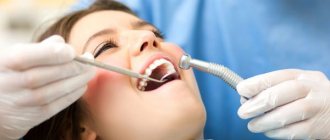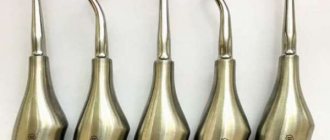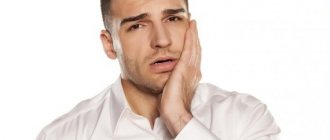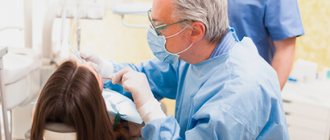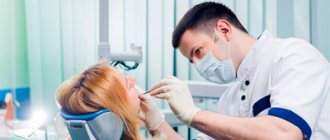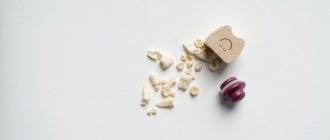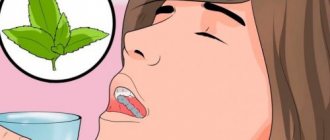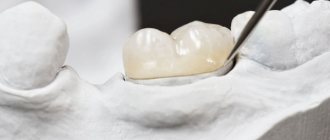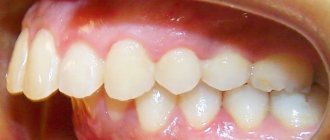1135
Bite is the relationship of the dentition in conditions of their complete closure (occlusion). All types of closure are divided into pathological and physiological.
The former are characterized by an abnormal position of individual teeth or their groups, disturbances in the size and/or relationship of the dental arches.
With a physiological (normal) occlusion, there is a balance of functional, morphological and aesthetic characteristics.
There are quite a few classifications of physiological types. But they all contain two main types - orthognathic (absolutely normal) and orthogenic or direct (borderline).
Characteristics
The main and only feature of a direct bite is that with it the lower and upper incisors close with their cutting edges.
In all other respects, the orthogenic type does not differ from the orthognathic type and has the following characteristics:
- The midlines between the maxillary and mandibular incisors coincide.
- There are no facial disproportions (the midline of the face coincides with the line between the first and second incisors).
- Speech is clear.
- The chewing process is not disturbed.
- There are no gaps between the teeth.
The contact of teeth with the orthogenic type fully meets the norm:
- The upper canines, with their tubercles, fit between the first premolars and the lower canines.
- The first upper molars have mesiobuccal cusps located in the transverse grooves of the first lower molars.
- The upper lateral teeth overlap the buccal cusps of the lower ones with their buccal cusps, and their palatal cusps fall between the lingual and buccal cusps of the lower antagonists.
- The dental arches of the HF and LF are symmetrical.
- There is a tight occlusion between all teeth except those that have not erupted.
- Physiological rest is characterized by a 2 mm occlusal space.
Advantages and disadvantages
Due to the fact that the direct bite is on the border between an anomaly and the norm, orthopedists call it borderline.
We can talk about advantages only in relation to obvious pathological conditions, such as distal or mesial occlusion.
In contrast, the direct type has:
- aesthetic appearance, open smile due to the tight fit of the mandibular incisors to the upper ones.
- fully preserved functionality - clear speech, free chewing.
- absence of tremata and diastemas.
- resistance to caries.
- absence of inflammatory processes in the periodontium.
Disadvantages of this jaw condition:
- The cutting edges of the anterior teeth are subject to increased abrasion, which can lead to complications such as tooth sensitivity and impaired aesthetics due to the reduction of the lower part of the face.
- The risk of developing certain deviations, in particular, bulging of the LF.
- Congestion of the jaws due to constant pressure of the teeth on each other.
- Possibility of disorders in the temporomandibular joints with subsequent development of periodontal disease. Possible clicking when opening the mouth, hearing loss.
Deep bite
One of the most common malocclusions. With it, the upper teeth completely overlap the lower ones.
Deep bite – the upper row of teeth completely covers the lower one
What's the harm?
Even if the front teeth are straight, the smile will be too “closed”; the lower third of the face will look disproportionately small. Due to improper closure, the enamel of the chewing teeth suffers.
Reasons for the development of anomalies
The following factors can contribute to the occurrence of orthogenic occlusion in children:
- Heredity. The most common reason for its formation, and, by the way, the most unfavorable. Treatment in this case can be lengthy and not always successful. If parents have a straight bite, it is highly likely that the same type will appear in their children.
- Unfavorable conditions during intrauterine development of the fetus and childbirth. Severe pregnancy, viral infections, metabolic disorders, low hemoglobin, birth injuries.
- Artificial feeding , sucking on a pacifier for too long.
- Mouth breathing due to frequent colds.
- Delay in teething , other problems of the dentofacial apparatus.
- Bad sucking habits – fingers, cheeks, lip biting.
- Injuries to the jaws and teeth.
Direct bite itself does not require mandatory treatment , since it is not a pathological type. But it is necessary to strictly monitor the condition of the dental system.
Like any borderline condition, direct bite carries the risk of developing anomalies. At the first signs of their appearance, you should consult a doctor.
What difficulties may arise for a person with a progenic bite, and how to prevent the development of anomalies.
Let's find out here how you can straighten your teeth at home.
At this address https://orto-info.ru/zubocheliustnye-anomalii/okklyuzii/postoyannogo-prikusa.html read about the stages of formation of a permanent bite in children.
Possible complications
- Destruction of enamel due to abrasion , the occurrence of tooth sensitivity (painful reaction to hot, cold, sour, sweet).
- Excessive load on the teeth , leading to inflammatory processes in the gums, bleeding, gingivitis, stomatitis, periodontitis.
- Damage to the TMJ , pain and clicking in the joints, headaches, difficulty opening the mouth.
- Reduction in the length of the front teeth due to their abrasion. The reduction in the length of the crowns can reach ⅓ or even ½, which is why facial aesthetics and chewing functions suffer greatly.
- Functional disorders. Problems with speech (talking through teeth), chewing, breathing.
- Increased risk of mucosal injury.
Children's teeth require special attention due to the high likelihood of developing serious anomalies.
How much does teeth straightening cost?
Our price for teeth straightening in Moscow is really affordable and lower than in many other dental clinics in Moscow. We guarantee effective bite correction at a reasonable price and attentive attention to the patient’s wishes. Sign up for a consultation with our specialists and find out the cost of correcting your bite at the DentalPRO clinic. Call 8 , any day of the week, from 10 to 21.
Bite correction
– this is one of the most painful topics for both adults and children. For many, the procedure for straightening teeth causes terrible associations and fear of excruciating pain. Fortunately, modern dentistry is developing rapidly and the techniques available today make it possible to treat a bite in a short time without pain and other unpleasant sensations.
The specialists of our dental clinic “DentalPRO” practice the most modern methods of treating dental anomalies and guarantee effective teeth alignment in any, even the most difficult cases. At the same time, the price of bite correction in our clinic is truly affordable and accessible to almost everyone.
Stages of orthodontic procedures in DentalPRO:
|
Diagnostic measures
Clinical examination (examination of the face and oral cavity) is the main type of diagnosis for direct bite. To establish hereditary causes, it is important to confirm or refute the presence or absence of this type in the parents.
In second place in importance are the methods of radiographic examination:
- Orthopantomography (OPTG) .
Panoramic photography with synchronous movement of the beam tube and film around the head, through which a complete image of the teeth, jaws, paranasal sinuses and TMJ is obtained in one picture. OPTG is a basic study that allows you to assess the general condition of the dentofacial apparatus. - Teleradiography . Frontal and lateral photographs of the face, showing the relationship of the jaws and dental arches in the sagittal, transversal and vertical directions, as well as compare the skeletal bones of the face with soft tissues.
- Occlusionography .
Study of occlusal contacts left on thin wax plates when teeth are closed. In this case, there are point contacts in the area of the lateral teeth and linear contacts in the anterior teeth. Excessive contacts manifest themselves as holes in the occlusiogram. If there are no dental contacts, there are no imprints on the wax. - Electromyography .
A diagnostic method that evaluates the electrical activity of the jaw muscles. It is performed using an electromyograph, the electrodes of which react to the electrical potential of the muscles and display its image on the screen. If the potential parameters go beyond the normal limits, this indicates a malfunction of either the muscle itself or the nerves.
How to correctly determine what to pay attention to?
Orthodontics deals with the study of bite and diagnosis of anomalies resulting from genetic defects, age-related changes, and environmental influences.
To determine the type of bite, the doctor studies the anatomical features of the jaw. Direct occlusion is characterized by tight closure of the dentition. The cutting parts of the crowns are in contact with each other. The central upper and lower units are smooth and located opposite to each other. There are no cracks.
If the orthodontist suspects problems, an in-depth diagnosis is carried out.
- First of all, the patient undergoes an orthopantomogram. A panoramic photograph shows the condition of the dentofacial apparatus.
- To determine the strength of the bite, an occlusiogram is prescribed. A man bites a wax plate. The remaining traces allow the study of occlusive contacts.
- An electromyograph is used to collect data on the work of facial and masticatory muscles. Using the device, the speed of nerve impulses is monitored.
- Teleradiography is used to obtain detailed images of the dental arches.
If the orthodontist suspects disorders that require correction, the first thing they do is an orthopantomogram. A
modern scientific approach and new diagnostic methods allow the dentist to see the slightest changes in the structure and function of the jaws and correct them in a timely manner.
Correction methods
The main danger of a direct bite is abrasion of the front teeth, which can reach 40% of the crown height.
The sooner the patient consults a doctor to correct abnormal phenomena, the less the enamel on the front teeth wears out.
For correction, depending on the clinical picture and age of the patient, various correction methods can be used:
- Fixed and removable orthodontic devices (braces, activators, function regulators).
- Aligners. Mouthguards are an effective, comfortable and aesthetic means of treating mild anomalies.
- Myotherapy . Exercises for chewing and facial muscles in order to normalize their functioning.
The simplest method of correction is to wear aligners - transparent aligners that transform a straight bite into an orthognathic one.
A good and effective method for children in whom, during the growth and formation of the dentofacial apparatus, it is enough to give the growing permanent teeth the necessary direction. Their disadvantage is their high cost.
Braces are used in more complex cases, when the formation of the dental system is complete , and significant effort is required to change the position of the teeth.
Refusal of correction can lead to complications of the borderline condition and the emergence of a situation in which it is necessary to correct much more complex problems than marginal closure of the teeth.
For example, making fixed dentures for the entire frontal row or performing implantation.
Reviews
Direct bite is a condition balancing between normality and abnormality, which at any moment can develop into a pathogenic process.
On the one hand, direct closure may never lead to problems, but on the other hand, it is dangerous to risk your health.
Share your opinion in the comments whether it is worth treating a direct bite or can you get by with prevention, for example, myotherapy.
If you find an error, please select a piece of text and press Ctrl+Enter.
Preventive measures
The risk of developing an anomaly in a child can be reduced to a minimum by the following measures:
- See your doctor regularly during pregnancy.
- Eat nutritiously during pregnancy (particular attention should be paid to foods containing large amounts of calcium).
- Breastfeed your baby.
- Control the baby's breathing (it should be nasal).
- Wean off the pacifier in a timely manner. Its period of use should be limited to three years.
- Take your child to the dentist regularly.
What is the period of mixed dentition, and what parents need to pay attention to.
In this article we will tell you all the most important things about senile progeny.
Follow the link https://orto-info.ru/zubocheliustnye-anomalii/okklyuzii/profilaktiki.html to learn more about the kit for the prevention of malocclusions.
Treatment price
The price depends on the type of treatment, removable devices, braces or aligners used.
The cost of treatment also includes consultation, diagnostic and preparatory operations - radiography, curettage, professional teeth cleaning, etc.
Below are estimated prices for individual operations and orthodontic treatment in general.
| Name of service | Cost, in rub. |
| Consultation | From 900 |
| Orthopantomogram | From 900 |
| Teleradiogram | From 900 |
| Occlusiogram analysis | From 1 500 |
| Closed curettage (1 tooth) | From 500 |
| Open curettage (1 tooth) | From 1 400 |
| Remineralization (1 dentition) | From 450 |
| Fixation of the retention guard | From 8 000 |
| Fixing the trainer | From 10 000 |
| Treatment with aligners (1 dentition) | From 170,000 |
| Treatment with aligners (2 rows of teeth) | From 200,000 |
| Treatment with self-ligating bracket system (1 row) | From 80 000 |
In the video, the doctor will tell you what a correct and incorrect bite is.
Benefits of Invisalign trays
- Efficiency. If you can correct your malocclusion with braces, Invisalign clear overlays will be just as effective, and often more effective.
- Convenience and easy care. The aligners can be removed while eating and brushing your teeth.
- Stealth. The aligners are made of durable and transparent plastic. They are invisible in conversation and in photographs.
- Comfort. When worn, the aligners do not create a feeling of discomfort in the mouth, do not rub the gums, and do not change the patient’s diction. It will take you a maximum of 2 hours to get used to them.
- Safety. Gums and tooth enamel are not damaged during treatment.
PROPRICUS dental specialists who will help you forget about dental malocclusion forever
Pokrovskaya Natalya Sergeevna
Head of the Department of Orthodontics
He specializes in solving problems with malocclusion using Invisalign aligners, and is involved in neuromuscular diagnostics and pediatric orthodontics. Work experience - 10 years.
Mironova Elena Sergeevna
Dentist - orthodontist
She treats dental malocclusions with Invisalign aligners and braces. Member of the professional society of orthodontists. Work experience - 7 years.
